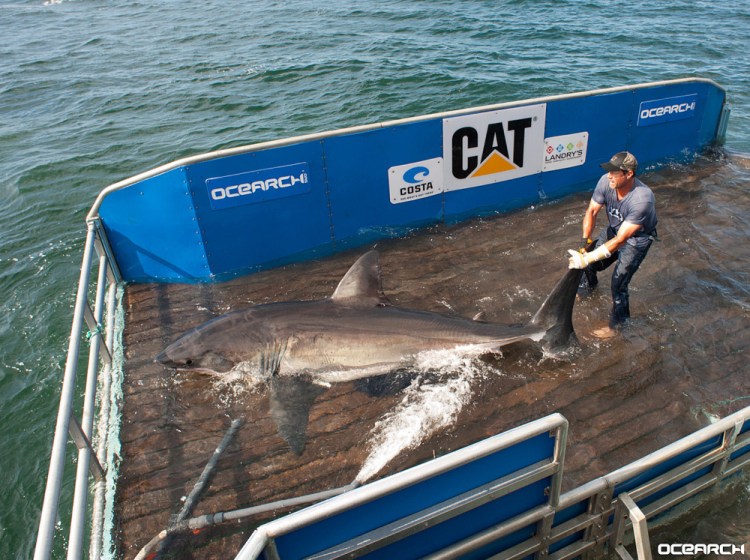Marine biologists are embarking on the first study dedicated to learning about the habits of great white sharks off the coast of southern Maine, where the scientists say the fishes’ population is likely to increase.
University of New England professor James Sulikowski will collaborate with Greg Skomal of the Massachusetts Division of Marine Fisheries to see how often the sharks come near the coast.
This week, Sulikowski will set up receivers on buoys around Wood Island, just off Biddeford. The receivers will detect great whites within a 600-foot radius that have been tagged with transmitters.
Great white sharks are the world’s largest predatory fish. Known for their powerful jaws and serrated teeth, they can grow to more than 20 feet and 4,000 pounds.
They have been protected from harvesting in U.S. waters since 1991. Skomal said the shark population has been rebounding since.
“We definitely believe the entire East Coast population is increasing and that we are likely to see white sharks in the Gulf of Maine increasing,” he said.
Although many supposed sightings of white sharks in Maine are actually sharks of little harm to humans, such as porbeagles and basking sharks, researchers have confirmed great white sharks in Maine and even in the Canadian Maritimes, Skomal said.
Last October, a 12-foot great white tagged by the research team Ocearch was detected in Cobscook Bay along Lubec and Eastport. Dubbed “Betsy” by the research team, the shark eventually headed up to Nova Scotia before sending off a final signal on Nov. 26.
“We tracked Betsy right into Maine. We know she was there for a month,” said Ocearch expedition leader Chris Fischer.
“We see our white sharks use these inland areas a lot. They’re fishing there, leveraging the area for forage, following bait runs, like a lion in Africa culling the weak.”
Skomal said white sharks have been inhabiting the Gulf of Maine possibly for a millennium.
“We have historical records dating back to the 1800s of white sharks in the Gulf of Maine,” he said. “And white sharks are an endothermic species – it can elevate its body temperature. That means it can tolerate and live in cooler waters.”
What scientists don’t know, Skomal said, is how often great white sharks travel into the gulf and which areas they utilize.
The receivers will pick up signals from transmission tags that can last 10 years on great whites. The shark does not need to surface for the transmission to be picked up by the receiver. With the shark tagged by Ocearch, its satellite transmitter sent out a signal only when it surfaced.
Eventually, Sulikowski hopes to spread more receivers along the Maine coast to track some of the 80 great white sharks Skomal has tagged in Massachusetts.
The Gulf of Maine is known to have a robust gray seal population, as well as other prey white sharks favor, such as spiny dogfish, tuna and harbor porpoise.

Calmed by a towel over her eyes, 12-foot Betsy is about to be tagged by a member of the research team Ocearch in August 2013. A protected species, she was detected last October in Cobscook Bay along Lubec and Eastport.
See where Betsy traveled last year: Ocearch.org/profile/betsy/
“It’s important to understand how the environment is changing,” Sulikowski said. “There are more seals now; it’s going to get crowded around Cape Cod. Great whites will look toward different areas. This is why this project is so important. We want to start now before lots of white sharks are here and we’re not ready.”
The Massachusetts Division of Marine Fisheries has been tagging and following great white sharks since 2009. To date, Skomal has tagged 110 great white sharks with transmission tags – and currently has 80 live transmitters. He said there are about 100 receivers in Massachusetts waters picking up the sharks’ movements.
The study has cost about $200,000 for the receivers and roughly $400,000 for the tags, Skomal said. But he added the receivers help to track many different species, such as sturgeon, striped bass and cod. It has been funded in part by the nonprofit Atlantic White Shark Conservancy in Massachusetts that was created in 2013.
The study originally was started to learn the white shark’s ecology and natural history, which scientists know little about, but Skomal is close to getting a population estimate of the white sharks around Massachusetts.
“This receiver technology is really good; it points to hot spots for white sharks,” Skomal said. “We know, for example, that the outer Cape (Cod) attracts a high density of gray seals, and that has emerged as a hot spot for white sharks.
“We want to find out if white sharks are using the Gulf of Maine as a highway. We know they don’t stop at the (Massachusetts) state border.”
Walt Golet, a researcher at the Gulf of Maine Research Institute, said tuna fishing along Maine inland waters this summer has been extraordinary.
Skomal said that definitely could affect white shark behavior this summer, bringing them closer to shore.
According to the International Shark Attack File, there has been only one reported unprovoked shark attack in Maine. That occurred in 2010 in Down East Maine. Skomal said the frequency of attacks on humans is not likely to increase.
Rather than fear white sharks, Skomal said people should be glad they’re in our waters because they are an “apex predator” that helps maintain a balanced ocean ecosystem.
“White sharks help to control the seal population. You need ecosystem balance, and top-down predators maintain that,” Skomal said.
Sulikowski agreed people have to learn to live alongside great white sharks.
“The ocean is the shark’s environment,” Sulikowski said. “We’re invading their environment. We have to figure out how to interact with them.”
Deirdre Fleming can be contacted at 791-6452 or at:
dfleming@pressherald.com
Twitter: FlemingPph
Send questions/comments to the editors.




Comments are no longer available on this story